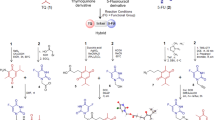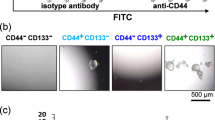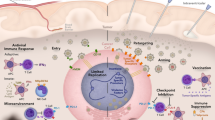Abstract
Cancer stem cells (CSCs), which are a rare population in any type of cancer, including colon cancer, are tumorigenic and responsible for cancer recurrence and metastasis. CSCs have been isolated from a number of different solid tumors recently, although the isolation of CSCs in colon cancer is still challenging. We cultured colon cancer cells in stem cell medium to obtain colonosphere cells. These cells possessed the characteristics of CSCs, with a high capacity of tumorigenicity, migration and invasion in vitro and in vivo. The isolation and identification of CSCs have provided new targets for the therapeutics. Oncolytic herpes simplex viruses (oHSV) are an effective strategy for killing colon cancer cells in preclinical models. Here, we examined the efficacy of an oncolytic herpes simplex virus type 2 (oHSV2) in killing colon cancer cells and colon cancer stem-like cells (CSLCs). oHSV2 was found to be highly cytotoxic to the adherent and sphere cells in vitro, and oHSV2 treatment in vivo significantly inhibited tumor growth. This study demonstrates that oHSV2 is effective against colon cancer cells and colon CSLCs and could be a promising strategy for treating colon cancer patients.
This is a preview of subscription content, access via your institution
Access options
Subscribe to this journal
Receive 12 print issues and online access
$259.00 per year
only $21.58 per issue
Buy this article
- Purchase on Springer Link
- Instant access to full article PDF
Prices may be subject to local taxes which are calculated during checkout






Similar content being viewed by others
References
O'Connell JB, Maggard MA, Ko CY . Colon cancer survival rates with the new American Joint Committee on Cancer sixth edition staging. J Natl Cancer Inst 2004; 96: 1420–1425.
Berrino F, DeAngelis R, Sant M, Rosso S, Bielska-Lasota M, Coebergh JW et al. Survival for eight major cancers and all cancers combined for European adults diagnosed in 1995-99: results of the EUROCARE-4 study. Lancet Oncol 2007; 8: 773–783.
Dalerba P, Cho RW, Clarke MF . Cancer stem cells: models and concepts. Annu Rev Med 2007; 58: 267–284.
Hart LS, El-Deiry WS . Invincible, but not invisible: imaging approaches toward in vivo detection of cancer stem cells. J Clin Oncol 2008; 26: 2901–2910.
Tang SN, Fu J, Nall D, Rodova M, Shankar S, Srivastava RK . Inhibition of sonic hedgehog pathway and pluripotency maintaining factors regulate human pancreatic cancer stem cell characteristics. Int J Cancer 2012; 131: 30–40.
Deng S, Yang X, Lassus H, Liang S, Kaur S, Ye Q et al. Distinct expression levels and patterns of stem cell marker, aldehyde dehydrogenase isoform 1 (ALDH1), in human epithelial cancers. PLoS One 2010; 5: e10277.
Huang EH, Hynes MJ, Zhang T, Ginestier C, Dontu G, Appelman H et al. Aldehyde dehydrogenase 1 is a marker for normal and malignant human colonic stem cells (SC) and tracks SC overpopulation during colon tumorigenesis. Cancer Res 2009; 69: 3382–3389.
Du L, Wang H, He L, Zhang J, Ni B, Wang X et al. CD44 is of functional importance for colorectal cancer stem cells. Clin Cancer Res 2008; 14: 6751–6760.
Ricci-Vitiani L, Lombardi DG, Pilozzi E, Biffoni M, Todaro M, Peschle C et al. Identification and expansion of human colon-cancer-initiating cells. Nature 2007; 445: 111–115.
Barker N, Ridgway RA, van Es JH, van de Wetering M, Begthel H, van den Born M et al. Crypt stem cells as the cells-of-origin of intestinal cancer. Nature 2009; 457: 608–611.
Chu P, Clanton DJ, Snipas TS, Lee J, Mitchell E, Nguyen ML et al. Characterization of a subpopulation of colon cancer cells with stem cell-like properties. Int J Cancer 2009; 124: 1312–1321.
Fan X, Liu S, Su F, Pan Q, Lin T . Effective enrichment of prostate cancer stem cells from spheres in a suspension culture system. Urol Oncol 2012; 30: 314–318.
Michishita M, Akiyoshi R, Yoshimura H, Katsumoto T, Ichikawa H, Ohkusu-Tsukada K et al. Characterization of spheres derived from canine mammary gland adenocarcinoma cell lines. Res Vet Sci 2011; 91: 254–260.
Rybak AP, He L, Kapoor A, Cutz JC, Tang D . Characterization of sphere-propagating cells with stem-like properties from DU145 prostate cancer cells. Biochim Biophys Acta 2011; 1813: 683–694.
Wei B, Han XY, Qi CL, Zhang S, Zheng ZH, Huang Y et al. Coaction of spheroid-derived stem-like cells and endothelial progenitor cells promotes development of colon cancer. PLoS One 2012; 7: e39069.
Russell SJ, Peng KW . Viruses as anticancer drugs. Trends Pharmacol Sci 2007; 28: 326–333.
Andtbacka RH, Kaufman HL, Collichio F, Amatruda T, Senzer N, Chesney J et al. Talimogene laherparepvec improves durable response rate in patients with advanced melanoma. J Clin Oncol 2015; 33: 2780–2788.
Liu BL, Robinson M, Han ZQ, Branston RH, English C, Reay P et al. ICP34.5 deleted herpes simplex virus with enhanced oncolytic, immune stimulating, and anti-tumour properties. Gene Therapy 2003; 10: 292–303.
He B, Chou J, Brandimarti R, Mohr I, Gluzman Y, Roizman B . Suppression of the phenotype of gamma (1)34.5 herpes simplex virus 1: failure of activated RNA-dependent protein kinase to shut off protein synthesis is associated with a deletion in the domain of the alpha47 gene. J Virol 1997; 71: 6049–6054.
Cassady KA, Gross M, Roizman B . The herpes simplex virus US11 protein effectively compensates for the gamma1(34.5) gene if present before activation of protein kinase R by precluding its phosphorylation and that of the alpha subunit of eukaryotic translation initiation factor 2. J Virol 1998; 72: 8620–8626.
Fidler IJ, Kripke ML . Metastasis results from preexisting variant cells within a malignant tumor. Science 1977; 197: 893–895.
Clarke MF, Dick JE, Dirks PB, Eaves CJ, Jamieson CH, Jones DL et al. Cancer stem cells—perspectives on current status and future directions: AACR Workshop on cancer stem cells. Cancer Res 2006; 66: 9339–9344.
Chaffer CL, Weinberg RA . A perspective on cancer cell metastasis. Science 2011; 331: 1559–1564.
Lawson JC, Blatch GL, Edkins AL . Cancer stem cells in breast cancer and metastasis. Breast Cancer Res Treat 2009; 118: 241–254.
Frank NY, Schatton T, Frank MH . The therapeutic promise of the cancer stem cell concept. J Clin Invest 2010; 120: 41–50.
Ponti D, Costa A, Zaffaroni N, Pratesi G, Petrangolini G, Coradini D et al. Isolation and in vitro propagation of tumorigenic breast cancer cells with stem/progenitor cell properties. Cancer Res 2005; 65: 5506–5511.
Fan X, Ouyang N, Teng H, Yao H . Isolation and characterization of spheroid cells from the HT29 colon cancer cell line. Int J Colorectal Dis 2011; 26: 1279–1285.
Feng Y, Dai X, Li X, Wang H, Liu J, Zhang J et al. EGF signalling pathway regulates colon cancer stem cell proliferation and apoptosis. Cell Prolif 2012; 45: 413–419.
Aghi M, Martuza RL . Oncolytic viral therapies—the clinical experience. Oncogene 2005; 24: 7802–7816.
Schatton T, Frank NY, Frank MH . Identification and targeting of cancer stem cells. BioEssays 2009; 31: 1038–1049.
Gupta PB, Onder TT, Jiang G, Tao K, Kuperwasser C, Weinberg RA et al. Identification of selective inhibitors of cancer stem cells by high-throughput screening. Cell 2009; 138: 645–659.
Lepourcelet M, Chen YN, France DS, Wang H, Crews P, Petersen F et al. Small-molecule antagonists of the oncogenic Tcf/beta-catenin protein complex. Cancer Cell 2004; 5: 91–102.
Huang EH, Wicha MS . Colon cancer stem cells: implications for prevention and therapy. Trends Mol Med 2008; 14: 503–509.
Todaro M, Francipane MG, Medema JP, Stassi G . Colon cancer stem cells: promise of targeted therapy. Gastroenterology 2010; 138: 2151–2162.
Zhao Q, Zhang W, Ning Z, Zhuang X, Lu H, Liang J et al. A novel oncolytic herpes simplex virus type 2 has potent anti-tumor activity. PLoS One 2014; 9: e93103.
Acknowledgements
echnical assistance from Jianwu Jiang and Xiaolan Li is appreciated. This work was supported by the National Basic Research Program of China (973 Program, Grant No. 2012CB917100), National Natural Science Foundation of China (Grant No. 81172160) and 863 Program of China (863 Program, Grant No. 2012AA02A407).
Author information
Authors and Affiliations
Corresponding authors
Ethics declarations
Competing interests
The authors declare no conflict of interest.
Additional information
Supplementary Information accompanies this paper on Gene Therapy website
Supplementary information
Rights and permissions
About this article
Cite this article
Yang, H., Peng, T., Li, J. et al. Treatment of colon cancer with oncolytic herpes simplex virus in preclinical models. Gene Ther 23, 450–459 (2016). https://doi.org/10.1038/gt.2016.15
Received:
Revised:
Accepted:
Published:
Issue Date:
DOI: https://doi.org/10.1038/gt.2016.15
This article is cited by
-
Tumor Microenvironment: A Niche for Cancer Stem Cell Immunotherapy
Stem Cell Reviews and Reports (2024)
-
Immuno-Oncolytic Viruses: Emerging Options in the Treatment of Colorectal Cancer
Molecular Diagnosis & Therapy (2021)
-
Recent advances in targeting cancer stem cells using oncolytic viruses
Biotechnology Letters (2020)
-
Prevalence of herpes simplex, varicella zoster and Cytomegalovirus in tumorous and adjacent tissues of patients, suffering from colorectal cancer in Iran
Translational Medicine Communications (2019)
-
Immunotherapeutic advances in gastrointestinal malignancies
npj Precision Oncology (2019)



